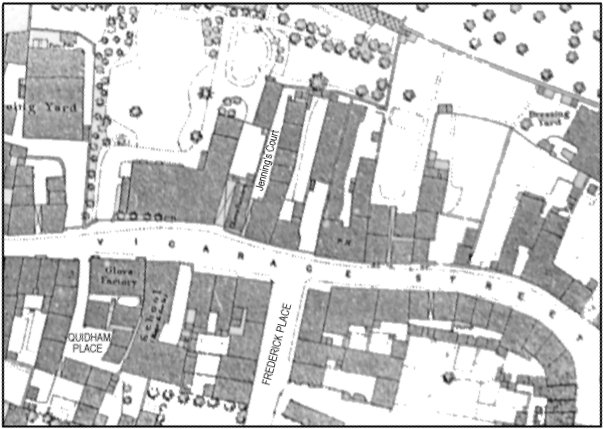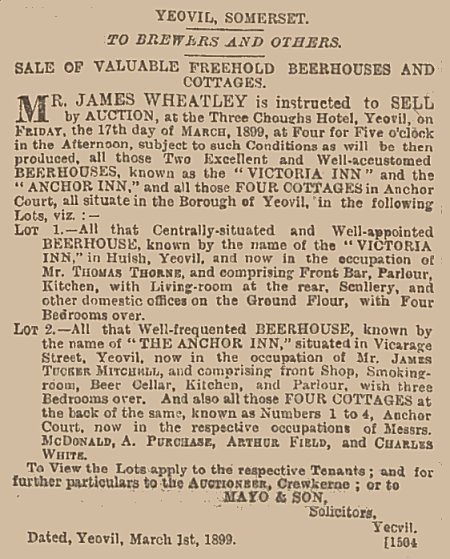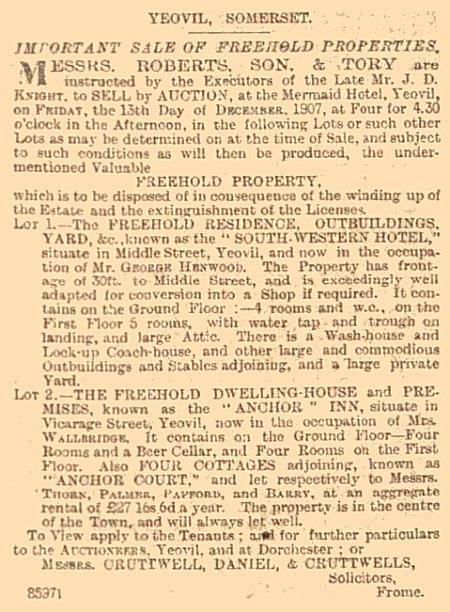jenning's court / Anchor Court
jenning's court / Anchor Court
Victorian slum housing off Vicarage Street
Jennings Court was a ‘court’ of slum housing - four 'cottages' - off Vicarage Street and reached by means of a narrow, covered dog-leg alleyway nestled between a small glove factory to the west and the Anchor Inn to the east. In the 1886 Ordnance Survey it was called Anchor Court. It was almost certainly owned and/or built by Robert Jennings or his son William. Robert Jennings was also responsible for the other great Yeovil slum - New Prospect Place.
In the 1851 census it was recorded that nine families lived there, a total of 43 people. Of these eighteen were employed in the gloving trade, chiefly women and girl outworkers, the youngest being aged 7. There was also one pauper and a man who described his occupation as a ‘traveller with basket’. Generally speaking they were the poorest of families who could not afford to live elsewhere.
In December 1851 (after a cholera epidemic in 1848-49) the Board of Health held a public enquiry, headed by Dr Thomas Rammell, the Board’s inspector, into the public health and sanitary conditions of Yeovil town. Dr Tomkins, in giving evidence at the enquiry, cited Jenning’s Court as an example of poor hygiene where all the houses shared one privy that was so close to the court’s well that it became contaminated.
In 1856 Daniel Vickery wrote in his 'Sketch of Yeovil' the following - “The disease most prevalent in the town is consumption, arising chiefly from overcrowding and the sedentary occupation of the females, as well as the factory employment of the male population. Epidemics are not of very frequent occurrence, and then chiefly in the lower parts of the town, such as Reckleford, Vicarage Street, Belmont, &c. The district, taken as a whole, is not naturally an unhealthy one, and were it not for overcrowding, bad ventilation, and stoves for the purpose of keeping the gloves free from damp, there is nothing to cause disease beyond the average of small towns. Such was the late Dr. Tomkyns' evidence upon the sanitary condition of the town, and it is most valuable, as being the experience of a professional man who had lived all his life in the town, and who was for many years the medical officer of the parish.”
The Anchor Inn together with the four 'cottages' of Anchor Court were sold in 1899. They were bought by Jonathan Drew Knight, brewer of Shepton Mallet and owner of the Royal Osborne Brewery. The inn and court were sold again in 1907 following the death of Mr Knight and the sale notice simply described the accommodation as four rooms on the ground floor and a beer cellar with four rooms on the first floor. At this time the licensee of the Anchor Inn was Mrs Wallbridge and the Anchor Inn and the four dwellings were bought by a Mr Wallbridge - presumably Emily's son - for £200 (about £115,000 at today's value).
Jennings Court was not demolished until well into the1930s and the late Tony Robins recalled "My brother was born in Anchor Court. One day mother put a nail in the wall to hang a mirror up but the walls were so thin that her neighbour came round to say thank you, as he could now hang a picture on his side of the wall."
map

This map, based
on the 1886
Ordnance Survey
shows Jenning's
Court to the
north of
Vicarage Street
and left of
centre on the
map.
Gallery

Just for interest - this item appeared in the 30 November 1892 edition of the Western Gazette. Apparently this was one of a dozen or so fires at the time and Dubbin had 'form' for setting a fire a couple of years earlier.

A notice of sale of both the Victoria Inn, Huish, and the Anchor Inn, Vicarage Street, (together with the four houses of Anchor Court) in the 3 March 1899 edition of the Western Gazette.

The notice of sale of the South Western Hotel, Middle Street, and the Anchor Inn, Vicarage Street, together with Anchor Court that lay behind it. These were the properties belonging to Mr JD Knight and were sold after his death. The notice was placed in the 6 December 1907 edition of the Western Gazette.